Michael Laub / Remote Control Productions
Portrait Series. Alone / Gregoire (2004)
PHOTOGRAPHY / VIDEO / CREDITS / PRESS
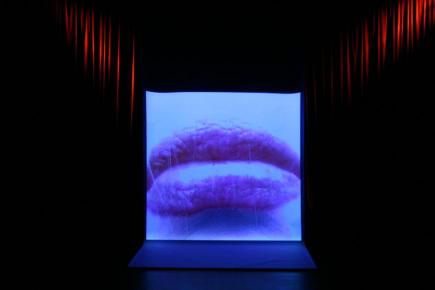
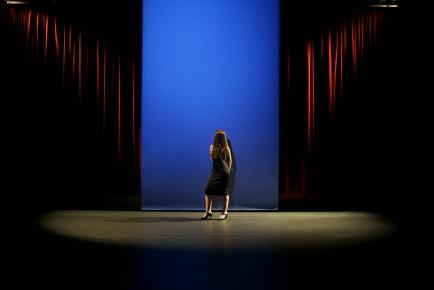
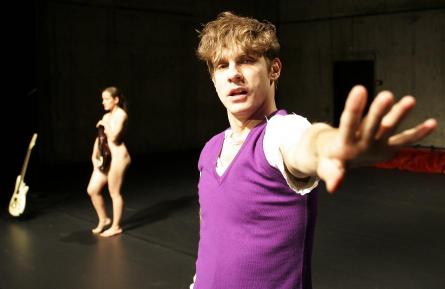
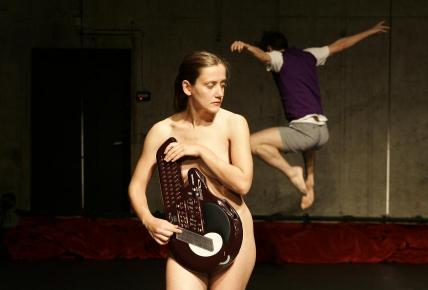
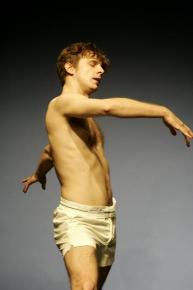
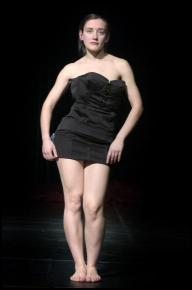
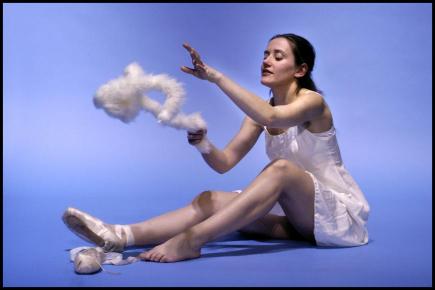
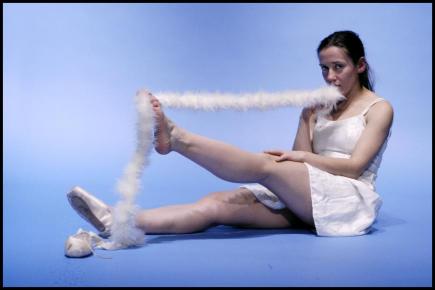
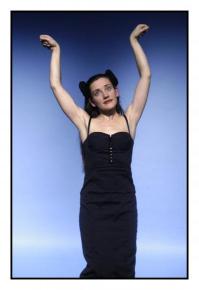
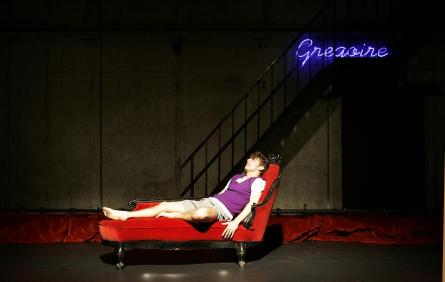
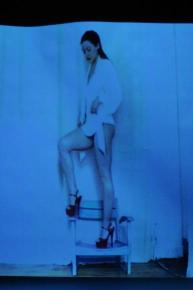

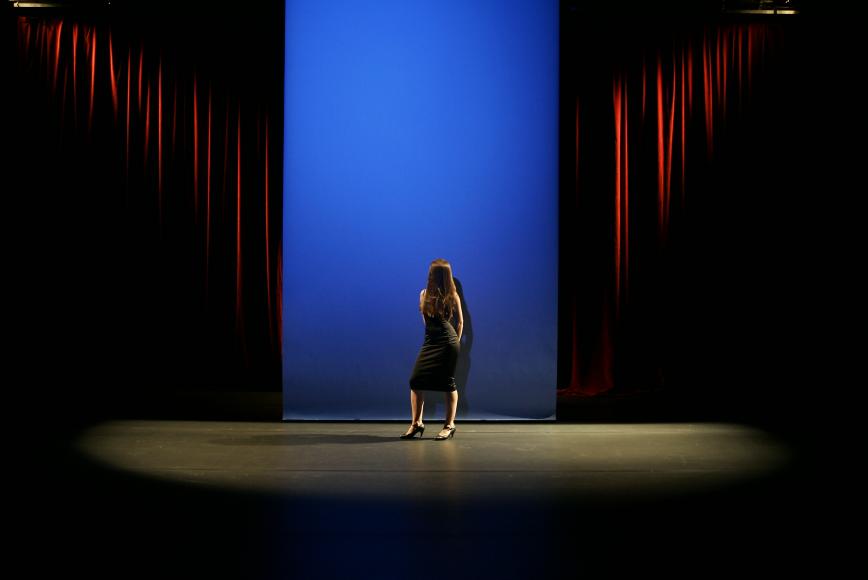
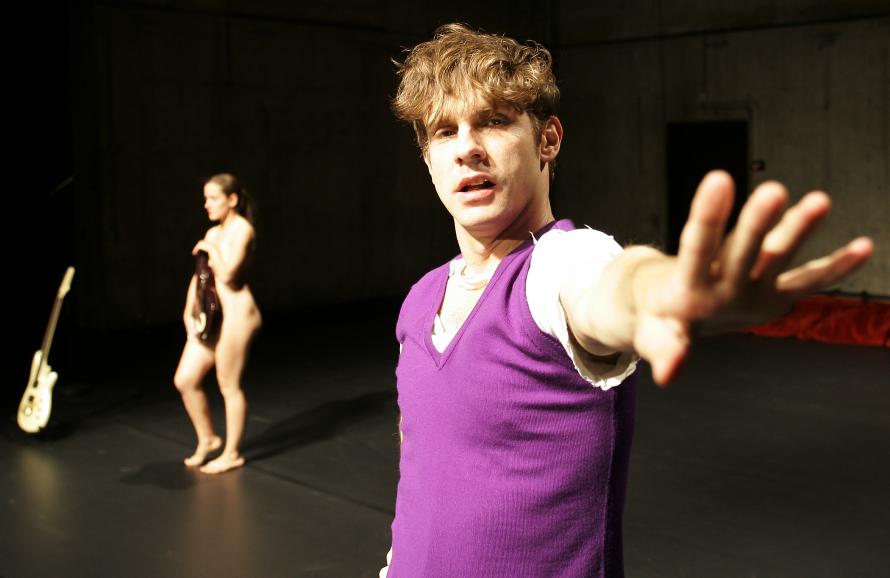
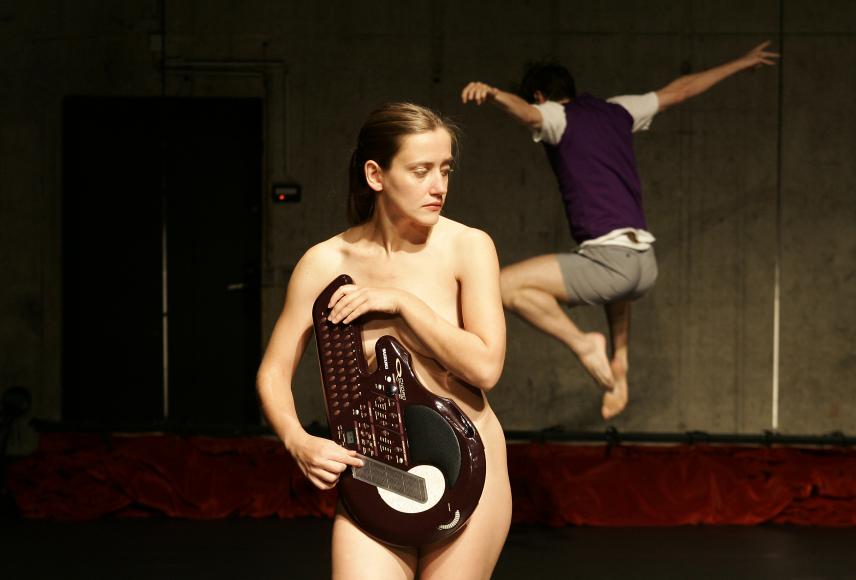
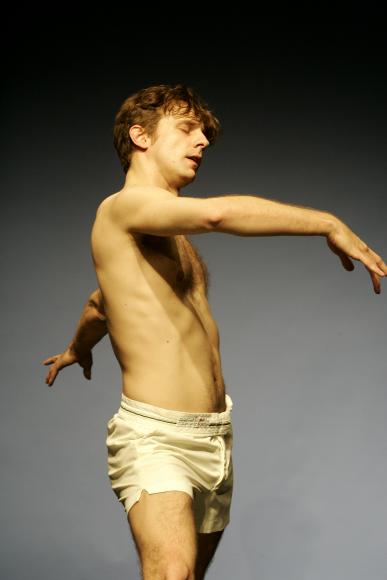
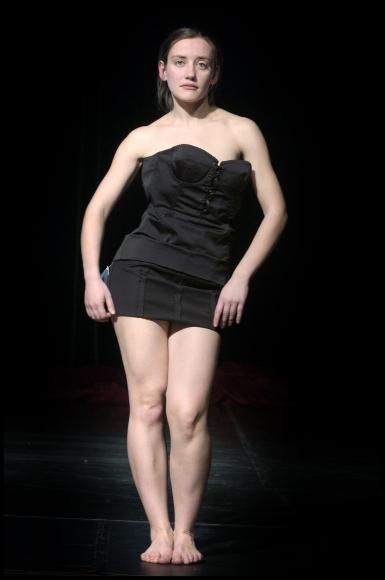
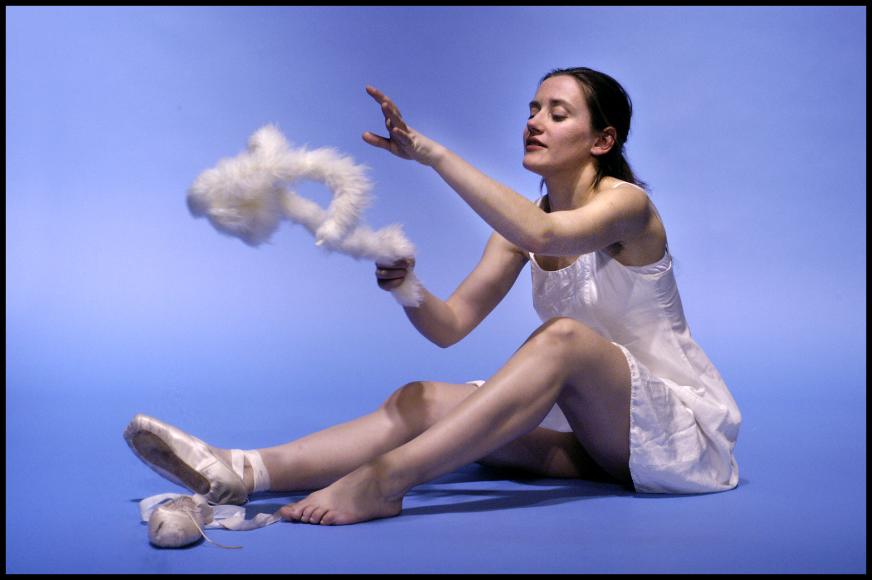
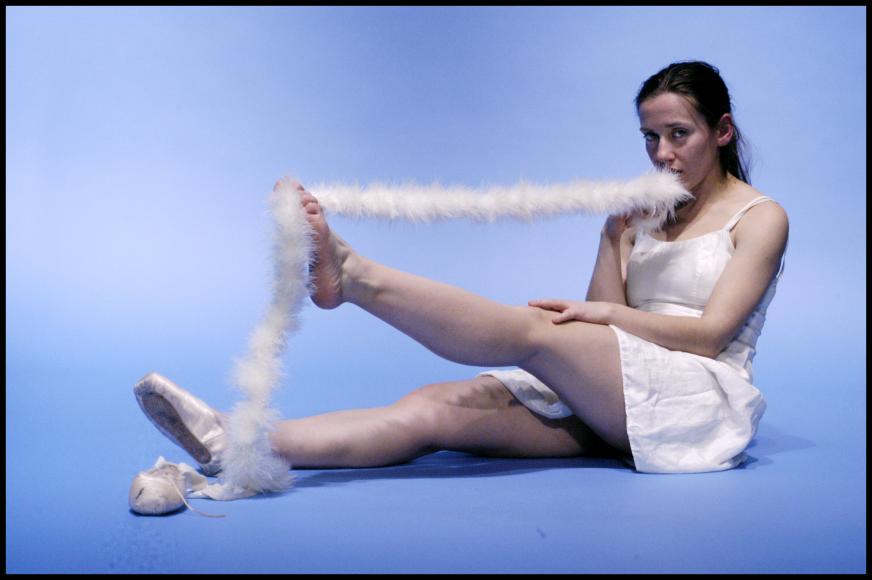
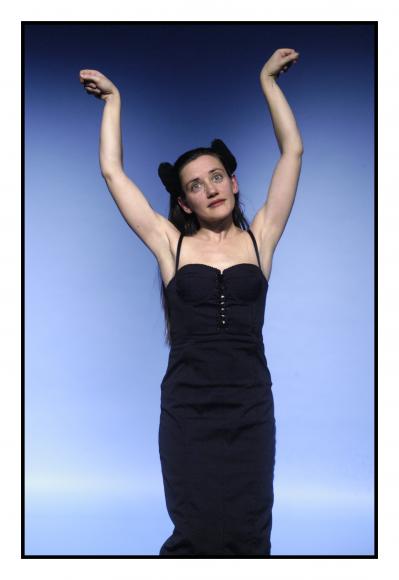
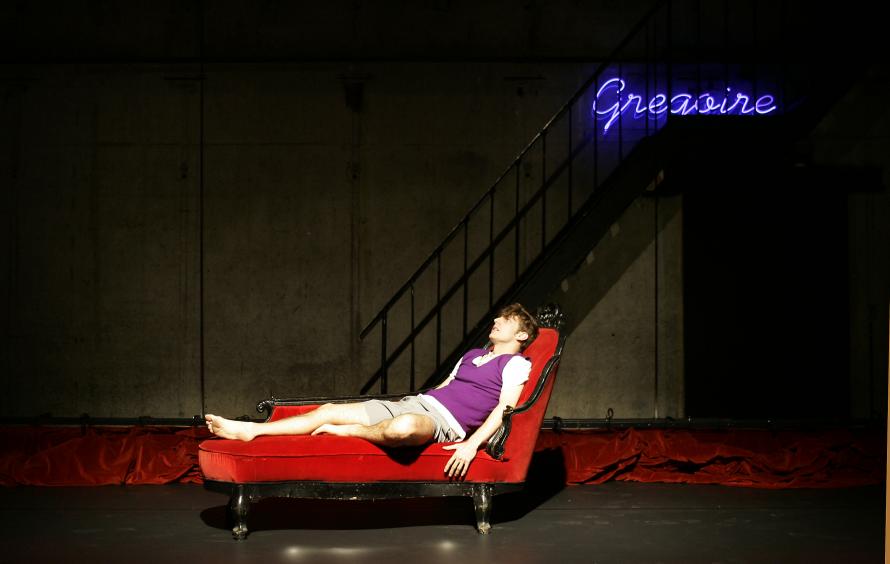

"After leaving Coquitlam I went to the Royal Winnepeg Ballett. It was horrible. One of my teachers was named Galina, she was from Bulgaria. And the first time she met me she said in front of the whole class: ‘This boy, I hate you’. Then she said: ‘Boy what your name?’ And I said: ‘My name is Greg.’ ‘Cake? What kind of name is Cake?’ And I said: ‘My name is Greg.’ And she said: ‘Cake, do people like you?’ And I said: ‘Hm...’ And she said: ‘Cake, I don’t think so.'"
CREDITS
Concept and Direction Michael Laub
Alone: Performance, Video and Costumes Astrid Endruweit
Gregoire: Performance, Choreography and Costumes Greg Zuccolo
Music Larry Steinbachek, Astrid Endruweit; Greg Zuccolo
Light Nigel Edwards
Sound Jean Pierre Urbano
Technical Director Jochen Massar
Production Management and Assistant Director Claudine Profitlich
Co-Produced by Remote Control Productions, Tanz im August 2005 – Internationales Tanzfest Berlin, Deutsches Schauspielhaus in Hamburg, Zürcher Theater Spektakel.
In Collaboration with RAZ Hans Tuerlings.
PRESS
emm., Frankfurter Allgemeine Zeitung, 13.2.2006
On-Stage Biography
Mousonturm: Michael Laub’s solos
When she was small she imagined what she might do and also what would doom to failure her prospective careers as a pullover saleswoman, actress and dancer. Astrid Endruweit communicates these childhood thoughts to the audience of her performance Alone. The street she grew up in (East) Berlin was named after the Soviet “liberation”, and perhaps that is why she so well knows – and shows – what she cannot be and cannot pretend to be. For instance: helpless women who permanently suffer. And in order to demonstrate that nothing is more dreary than harmony, the round-eyed performance artist plays an instrument that allows even the tone-deaf to compose their own tired elevator muzak.
The Mousonturm audience first had a chance to make Endruweit’s acquaintance some five years ago, when she presented her highly intensive and partly biographical solo pigg in hell, an excerpt from which re-emerges in the present performance. She started out as Michael Laub’s new discovery, and joined that director’s Remote Control Productions. What came before that is depicted in Alone, which she co-created with Laub, whose plan is to portray every member of his ensemble. Endruweit and Greg Zuccolo were now to be seen in their own portraits at the Mousonturm.
Contemporary Performance Art likes to put autobiography on the stage – but the results are not always convincing. Sometimes it leads to sheer narcissistic self-reflection no less dismal than the music Endruweit entices from her synthesizer for the musically challenged. However, both of Laub’s portraits demonstrate clearly how experience and presentation can blend, how a playful approach to “authenticity” can bear fruit. The way Zuccolo dances in his solo Gregoire, the second of the evening, is a demonstration of the way he overcame a classical training. Interwoven with rather cynical tales and self-penned rock songs, the result is a fragile creation in which the unstudied, the knowledge of that which should not be, emerges as the performance itself.
Endruweit displays a similar phenomenon when she insists on the random. She does so in a well-deliberated solo that masterfully spins weaves threads between the text delivered in English and broadest Berlin vernacular, the live re-enactments, and flashbacks to earlier Laub production. This variety of means is not the only reason why Edruweit’s significantly longer solo is more convincing than Zuccolo’s Gregoire. However, that both are pulling together is revealed not only at the moment when Endruweit pops up in the middle of Zuccolo’s monologue, stands there like a baroque putto with a muzak-synthesizer for a fig leaf. That’s highly entertaining, faintly enigmatic, and very stimulating – like the entire evening.
Ingrid van Frankenhuyzen,NRC, 17.09. 04
Pearls of intimate dance with dirty toes
Internationale Keuze Schouwburg Rotterdam (International Selection Rotterdam City Theatre): Alone/Gregoire of Michael Laub/Remote Control Productions.
Astrid Endruweit learned how to play the tompet with the Berlin’s equivalent of the Jostiband. It was cheap. On stage she picks up her trompet, after recalling this memory, she kneels down, sticks the instrument backwardly inbetween her legs and plays a couple of tunes. Composed and calm as if she is living in one big understatement.
Endruweit has poured memories into a theatrical shape before, these past years, together with her director Michael Laub and his company Remote Control Productions. These were, like in the new solo ‘Alone’, reasonable everyday memories, but the alienated deer eyes of the German gave the stories an eerie shine.
Endruweit has grown, in ‘Alone’ she does speak about her childhood dream to become a ballerina – or a tempting tall woman – but the exhibitionism for exhibitionism’s sake does not exist any longer. The scenes are intimate but still aimed at communication. She has a sense of humour and acts like an idiot in a familiar way. Laub makes her pull faces and act slutty, things that most like to do secretly, on stage. Anecdotes about fitting underwear in fitting rooms, the dirt accumulated between toes, to piddle on a keyboard helplessly; the sketches are beautiful. Towards the end Laub and Endruweit seem to be missing something, still the autobiographic portray is worth a trip to the theatre.
Another actor/dancer of Laub’s company, the Canadian Greg Zuccolo, does his solo in the same program. In ‘Gregoire’ he pours his anger out and sings oneliners into the microphone. His solo is his Freudian confession, because it all starts on the divan. While singing he discribes his dream where he is a glass of milk and reminisces about a Bulgarian ballet teacher. Nothing resembles esthetic ballet, no, he rather talks about how much everyone loves meat.
‘Gregoire’ is not finished yet but at this point the contrast between Endruweit and Zuccolo offers a beautiful night. With small and intimate theatre full of familiar memories.
Laub turns them into little pearls.
Katrin Jäger, die tageszeitung, 13.9.2004
An Affront to Good Taste
In Alone and Gregoire, two very dissimilar performance-portraits were presented in the Malersaal under the direction of Michael Laub
Astrid Endruweit is gagging, her mouth half-open, her tongue fighting to find its way outside through tensed-up lips. When at last that organ sees the light of day, Astrid Endruweit grins with relief. And the red monster recoils, rushes back into the cavity of her mouth. It’s kind of revolting, especially since this battle between her will and a wayward tongue is being presented to the viewer in close-up on a screen hanging on the stage like a curtain.
At the same time, the performer’s struggle with her lingual muscle is funny. For in the premiere of the solo Alone she steadfastly maintained the appropriate ironic distance to whatever she was doing, blithely chattering about herself all the while. Telling us about the young girl in East Berlin, for instance, who dreamed of being a Russian cartoon figure, devoid of fixed date of birth or specific gender, but with black furry ears instead. She puts them on, and this plain gesture, coupled with a few clear sentences, opens up spaces of fantasy in the viewer’s mind.
With her sequence of video clips, acted scenes and musical interludes Astrid Endruweit launches the new conceptual work of the Belgian performance artist Michael Laub: He asked each member of his company to work out a self-portrait performance. Endruweit narrates her loser’s biography in strong words. “I wanted to be an actress when I grew up, but I didn’t know what roles I wanted to play. Only those I didn’t want to play. Women in a permanent state of crisis, for instance, or ones permanently worried about being cheated, or permanently just weak,” she declares, and sways her hips in a black corset with over-large bust. And so she presents her failure as a critique of the stereotypical portrayal of women as victims in film and on the stage. Endruweit dreams of being the most beautiful of all celluloid divas, one all the men fall in love with. “And then I just say: Sorry, how dare you even think of it.” The sort of thing film divas seem to say – and suddenly the red theatre curtain galls noisily to the floor. From the loudspeakers blare the stock phrases in chorus, overlayer each other underscored by Endruweit’s hysterical laughter.
She removes the solemnity from the idea of the diva, cheerfully reduces it to absurdity. “An Affront to Good Taste” – so runs the title on the screen as Endruweit squats absentmindedly on the floor and gives us a concentrated report of how the fluff of her ballet stockings rolled up into tiny sausages of dirt between her toes. Lying on her back, her knees up to her ears, her black skirt rolled up so high that you can see the crack of her buttocks, the woman plays the trumpet placed between her thighs and provocatively staring out at the audience. The picture Endruweit paints with her body is powerful, one that breaks with visual habits. As does likewise her transformation into the alter-ego of the grumbling old man who thinks everything is “shit”.(...)
Peter Exinger, Sonntagsblick, Zürich, 29.8.2004
The Many Faces of Astrid E.
In Alone Michael Laub directs an actress who masterfully slips into various female roles
There is one person standing on the stage at the Rote Fabrik arts centre. Not standing, in fact, but walking – on the spot – with a sway. The black dress dictates a calm pace – left, right, left again – and in doing so moulds the body. There is a humming in the air. Tones resonate as if coming from the bellows of an accordion.
Astrid Endruweit is playing a quietly smiling embodiment of the role of Astrid Endruweit. She delivers a fifty-minute portrait of herself – and of her countless faces. What did she dream of being when she grew up? When she walked along “Liberation Street” as a child in Communist East Germany, she dreamt of selling pullovers – already yearning to be somebody else, to be allowed to develop her potential. And just as she demonstrates how items of clothing are folded and unfolded, so her face can show “astonishment”, “fear” or “happiness”. She can make her face radiate any one of these emotions, or all of them at once. It then takes on a frightfully harmonious look that matches the guitar synthesizer.
Behind these casual grimaces, however, there is more: the code of female roles. On the stage and in videos, she shows us: Wanting to be a lady, being a sex object with red high-heels on a wooden chair, or a catwoman pawing the tiled floor of a bathroom.
Based on natural strength, her performance interprets a varied range of emancipatory endeavours. Astrid Endruweit reveals to us the back entrances of her mind with all its secret desires.
While there is nothing secret about her message, it is little known: We can slip into the persona of anybody else, we are never wholly ourselves (and who are we in the first place?), there is nothing to stop us playing with our wishes and identities, we can re-invent ourselves in order to finally move on from our old selves. – A statement which there is every reason to applaud!
Christina Thurner, Neue Zürcher Zeitung, 30.8.2004
Self-Citations
Alone with Astrid Endruweit in the Rote Fabrik
Even as a child she was determined to be a ballerina or an actress. Stood in front of a mirror practising expressions of surprise, delight or fear – or all of them at once. And we, the audience, shudder with delight as we watch her eyes open wide and the corners of her mouth touch her ears. In her solo portrait Alone, produced by Michael Laub, Astrid Endruweit again delivers astonishing evidence of her supple stage presence. In the proverbial twinkle of an eye she has mutated from ingenue to vamp, from the innocent teller of apparently innocuous anecdotes of her GDR childhood to the provocative hussy captured on video who sticks out her tongue at the audience.
In the process she cites not only current theatre clichés and female stereotypes but also the way she has presented herself in earlier pieces. And so we see brief moments from Pigg in Hell, the solo which two years ago mesmerized audiences at the “Zuercher Theaterspektakel” and now illustrates her actor’s resumé. Alone seems like an autobiographical best-of-sampler of scenes which sometimes delight, sometimes appal. The overall effect is of being somehow arbitrarily compiled, yet even if the alternating doses of terror and ecstasy leave a less enduring impression than her earlier performances, the soloist is a bundle of energy who more than fills the empty space with her looks, expressions, stories and gestures. How fortunate that she decided to go on the stage instead of opening the pullover shop she dreamt of as a child.
Sylvia Staude., Frankfurter Rundschau, 14.2.2006
Pullover Folder
Bodies in Narration: Michael Laub’s “Portraits” in the Mousonturm
Matters – be they big or small, fact or fiction – land in Michael Laub’s pot. He vigorously mixes them all up, then starts separating a few strands. And the result is theatre. No more than a few words, perhaps, but suddenly major emotion is there. Sometimes he chooses widescreen format (Total Masala Slammer), sometimes intimate theatre. Laub’s pieces, which self-confidently do without storylines and are permanently in search of authenticity, need performers who hold them together, who need only appear on the stage and suddenly anything seems (and generally is) possible – see pigg in hell, the tour-de-force by the extraordinary Astrid Endruweit.
As a member of Remote Control Productions, Endruweit has been appearing in pieces by the Belgian director and choreographer Michael Laub since 2000, Greg Zuccolo joined the ensemble in 1998. The two solos – Alone (Endruweit) and Gregoire (Zuccolo) – were individually co-created with Laub and belong to an on-going series of portraits. Endruweit’s solo takes up more than two thirds of the barely ninety-minute-long presentation. And Zuccolo may well have been glad of the brevity of his performanceon this particular evening at the Mousonturm. He announces that his portrait will be one with “bruises” – he got beat up in Frankfurt the day before.
Astrid Endruweit tells of her early career plans (to be a folder of pullovers) and of practising facial expressions in the bathroom mirror (she gives us a superb demonstration). The pullover shop that so fascinated her was in the (East) Berlin street commemorating the “liberation” by the Soviets, back in the days when she thought she was too dirty to be a ballerina. Greg Zuccolo tells us about the murders in his Canadian hometown Coquitlam (in British Columbia) and about his ballet instructors – it sounds like Galina from Bulgaria may well have been the worst. All this is interspersed with offensive little films showing Endruweit noisily biting off her false fingernails, for instance, or choking on her tongue. In-between times Zuccolo breaks into song and dance, and they are outbreaks indeed, as if he wants to document that he has long overcome Galina’s psycho-terror. He can sing as loud and off-key as he likes.
Neither performer needs much text. Their bodies have as much, if indeed not more, to say. The Mousonturm is an intimate venue, and they are close to the audience, thrust themselves upon them. But, after all, one has been overpowered in more brutal fashion.
Edith Boxberger, Ballettanz, 2004
Liberation Street
A fleeting moment of ironic overstatement: Greg Zuccolo in the pose of a star, lounging on a red velvet sofa at the very back of the stage, remote from his audience in the Hamburg Schauspielhaus. And then he flees this beautiful bad dream, moves towards the front of the stage ramp as if wanting to demonstrate just how much distance he put between himself and celebrity hauteur. As a small boy he trained at the Royal Winnipeg Ballet, today he dances with the New York choreographers Sarah Michelson and Terence O’Connor and is a member of Michael Laub’s Remote Control ensemble. Although classical dance is part of his past, when he begins to dance Gregoire we see that it remains an indelible frame of reference. His solo is a brief statement of vehement searching. With stupendous energy Zuccolo makes the clear lines vanish, picks up the electric guitar and plays something utterly devoid of harmony. Perhaps only in order to drown out the nasty little tales he casually tells. Most of them are about glaring linguistic misunderstandings – his Bulgarian ballet teacher understood his Christian name to be “Cake”, and that was reason enough to write him off. His severe sideswipes at the power of the word make it seem as if language, that most rational means of communication, might be particularly fragile terrain.
Astrid Endruweit, for her part, is highly conversant with ambiguous signals. After every scene in Alone she slaps on a wide schoolgirl smile that beguiles and chills at the same time. Those faces in which she blends conflicting emotions – for example, fear and joy – suit her particularly well. First she tries them out live, and then repeats them, blown-up, in one of her self-shot home movies. On one occasion she greets her visitor-viewers from under a heavy layer of make-up, her blood-red mouth dancing about as it forms non-stop kisses. By the end it can do no more than jerk mechanically like a tormented heart.
Astrid Endruweit’s ability to laugh at herself makes bearable the horrors she reveals in Alone. The title stands for self-doubt and loneliness, but at the same time for the strength to help oneself. Just as there was a certain incongruity about many of the things she set out to do in life, so the skimpy bodice of her dress stubbornly resists the sway of her hips. Unfazed, she repeatedly adjusts the garment.
It all began in Berlin in a street named after – of all things – the “Liberation”. With enigmatic naivety Endruweit talks about her dreams of the stage, and a fragment of the reality of her life shines through. Suddenly, her clearly enunciated school English switches to German: by no means did she want to play one of those women who are in permanent crisis, have no boyfriend, and are seeking attention. She much prefers to cover her face with her long hair and to squeal like Uma Thurman, as if she were the avenging angel from the last Tarantino film.
In the case of Astrid Endruweit, that all takes place in the smallest possible space, in a small movement, an exaggerated bodily image, in the microcosm of her mimicry. Her art of intensification and Laub’s mania for the minimal mutually outdo each other. Obliviously she pulls a white feather boa through the gaps between her toes and reminisces about her dreams of becoming a ballet dancer. They were doomed from the start – for one thing, she could never have put up with the dirty feet.
Language, film and music superimpose themselves over each other in a multilayered composition. Astrid Endruweit plays an electronic keyboard which issues only harmonious chords and in the process almost falls asleep on her feet, but wakens up everybody in the audiences when, her skirt hitched up, she sends shrill trumpet blasts sounding through her legs or barks for all her friends who “see her as a dog”.
Fortunately, she did make onto the stage in the end. She attributes the blame to an “overpriced” workshop ran by a director who asked her what her improvisation was meant to represent. “A Pigg in Hell,” she replied – and the rest we know.
Mieke de Bont, Rotterdams Dagblad, 17.09.04
Laub sketches lovely portrays
Everything comes to life, even the attributes on stage. With music, footage, but especially with a very physical way of narrating, Astrid Endruweit drags you into her own authentic story. Sadness and frustration are at times palpable in ‘Alone’, but the slightly ironic humour keeps the overall tone pleasant.
Endruweit looks back at different phases in live and thinks about the desires she had then. As she wobbles on her toes in a moving way, her shoulders pulled back, she is a little naive girl who wants to be a vendor of pullovers. The acting dream takes shape with the practice of expressions in front of the mirror. Those eyes! Wide open or looking at you in a penetrating way, shallow with fear or blissfully happy she combines being afraid with joy or amazement.
There are some tears when she tells about the the roles she does not want to play, those of abandoned, betrayed or lonely women. As if she knows that side of life well enough. Tall, elegant and arrogantly she plays the lady she has always wanted to be. With favourite oneliners such as “How dare you fall in love with me!”. She wiggles, turns her upper body to the front and throws her behind to the side. Word and movement reinforce each other.
The red velvet curtain which falls down emphasizes the tackiness. It is beautiful how image, music, text and movement flow seamless into each other. Endruweit remains captivating, also in the vunerable little shots in which the camera is literally on her skin or shows the insecure posture beyond the high heels.
Theatre maker Michael Laub has made portrays out of his performers. He believes that a personal story deserves more then the name solo. Heavenly blue backdrops refer to photography, an art form in which portrays are an substantial part of the medium. Greg Zuccolo dances ‘Gregoire’. Initially he installs himself onto a chaise longue. Aloof, hair messy, as if he is getting back into bed. His ballet education does not betray him. He whirls with quick spins from a classical movement language, across the floor. “It is my solo show,” he screams to the audience. To let them see and hear energetically that he chases dreams, horses and Jason. A naked Endruweit obviously does not move him at all.
The bouncing, turning and shaking dance moves are beautifully in contrast with his classical basis. Zuccolo tells more with his swirling then Endruweit, with a more dancing and singing expression. ‘Gregoire’ is still under construction. Still, at this stage there is unity within the diversity.
KMR, Die Welt, 13.9.2004
Two Stage Ducklings Dream of Swan Lake
Michael Laub is still in search of intensely physical experience of identity. After his Porträts 360 Sek. the Belgian director has returned to the Deutsches Schauspiel Haus in Hamburg with the two solo pieces Alone and Gregoire. This time, however, the subjects portrayed are not personnel of the theatre but two members of his own English-speaking ensemble. Not for the first time, he physically approaches the question of the actor and his roles.
Laub narrates as tragedies the careers of two artists; or, put better: the two soloists tell their own story. Astrid Endruweit forces herself into a black corset dress in Alone, and tells us about her childhood dreams of what she would be when she grew up. She looks like an ugly duckling trying on for size different swan costumes. Once she has given a lethargic account of her dream job of folding up pullovers in a boutique, she moves onto her preparations for a career as an actress and ballerina, and we are treated to the sight of the dancer stumbling and fumbling her way across the stage. Then comes the actress-in-the-making: The petrified mouth widens into a gash, her eyebrows fearsomely meet below her hairline. Even more astonishing are her eyes, those huge Basedow organs she rolls until they are rotating spheres which then narrow into smiling slits.
The dancer Greg Zuccolo is also in search of his own identity, and in Gregoire he too looks like a plucked fowl: A duckling who is looking for Swan Lake. And his pond is a red chaise-longue, a shabby red curtain, and plenty of empty space. He clenches and unclenches his biceps like an excessively taut guitar string. Somewhere between hysteria and apathy he describes key experiences from his childhood and adolescence, his thorny path as a student of the Royal Winnipeg Ballet. Now involved in more experimental projects, he is getting his own back on the elite world of classical dance.
Identities certainly do emerge from Michael Laub’s multimedia portrait series; no matter how hackneyed the role, the individual always comes to the fore. Porträts 360 sek delivered fourteen 6-minute-long portraits amounting to a group picture of the Hamburg Schauspielhaus. With his two new solos, Laub tells us about the loneliness of the individual for the duration of 80 minutes.
-itz, Hamburger Abendblatt, 13.9.2004
Solos in the Malersaal
The first premiere on the small stage of the Schauspielhaus took place on the appointed date with two wholly self-sufficient guest performers: Astrid Endruweit and Greg Zuccolo. The two solos Alone and Gregoire, produced by Michael Laub, delivered proof that encounters with genuine personalities full of self-irony can be as stimulating, exciting and charming for the audience as any elaborately staged theatre spectacle. Endruweit blows a trumpet. On her knees, through her thighs. Defensively mocking provocation. Presenting herself as a jack of all trades who is master of none, she demonstrates a craft which is the product of a stubbornly child-like refusal to live up to the usual expectations. She preferred instead to pursue her dreams – such as those of becoming an actress or ballerina. It didn’t happen. And yet it is happening, now, in an originally offbeat mixture of stand-up comedy, cinema, Butoh, and theatre. Apparent failure can be turned into comedy, melancholy and a feisty innocence.
Endruweit uses the viewer’s eye as a mirror in which she studies herself, in front of which she poses, and subjects herself to investigation and production – in search of memories, desires, and blueprints of herself. The Canadian dancer Greg Zuccolo shows in Gregoire that he can dance, but not as dictated by his instructors or choreographers. Beginning with the typical steps, he soon leaves the beaten track, deconstructing ballet figures, producing buckled, heel-bound yet still elegant pirouettes, and actually seems to prefer singing his little songs into the microphone.
Both solos are continuations in Laub’s series of humorous self-portraits of individualists begun with Porträts 360 Sek in 2002.
Ursula Pellaton, Zürichsee-Zeitung, 30.8.2004
Dance As the Art of Being
Zurich: Astrid Endruweit’s impressive imaginary-authentic portrait of a dancer
The solo Alone, a joint premiere for Remote Control Productions and the Zurich Theaterspektakel, is a highly successful co-production. Not for the first time, audiences were deeply impressed by Astrid Endruweit’s inimitable powers of expression, which in Michael Laub’s concept and direction find an outstanding vehicle of presentation.
The subject of great art is art. Astrid Endruweit’s Alone, directed by Michael Laub, takes issue with the biography and self-portrayal of a stage artist, shows a dance piece in the making and as a finished product, and altogether makes visible on the stage the interplay between appearance and reality. The material is a multifaceted biographical portrait variously combining the external and internal views, and interrelating the private and the artistic, authentic and imaginary experiences. It is a portrait of a dancer, that is of an artist who directly embodies her art and trains her own body to be an instrument, uses it as the bearer of a message and as an effect, and exposes it to the gaze of the audience.
It is a piece about self-representation, about credibly articulating instinctive and emotional reactions, and deliberately producing emotions. And it is about the authenticity with which real and imaginary experiences can be produced for a staged performance. Astrid Endruweit articulates these topics verbally and nonverbally in virtuoso and comic fashion. Like her first joint piece with Michael Laub Alone consists in an apparently improvised sequence of single scenes; however, the contrasts are telling, and the transitions artful.
Endruweit begins to give a naive account of her childhood. At the age of four she wanted to work in a shop selling pullovers, so fascinated was she by the motions of unfolding then refolding. Having dawdled enough on this subject, she plunges into the heart of the matter: the tale of how she wanted to become an actress and the parts she played in her dreams. And before our eyes we see her talent and masterful body control take effect as they translate modes of behaviour and perceptions into typical postures and characteristic movements.
Ursula Pellaton, Der Landbote, Winterthur, 30.8.2004
Authentic Portrait
Astrid Endruweit’s triumphant dance self-portrait was a grand finale for the Zürcher Theater-Spektakel.
Great art takes art as its subject. Alone, a co-production of Remote Control Productions and the Zurich Theaterspektakel, is a highly successful solo written by and featuring Astrid Endruweit. Directed by Michael Laub, the piece looks at the biography and self-portrayal of an artist, shows a dance performance in the making and as a finished product, and altogether makes visible on the stage the interplay between appearance and reality.
The material is a multifaceted biographical portrait variously combining the external and internal views, and interrelating the private and the artistic, authentic and imaginary experiences. The portrait is one of an artist who directly embodies her art and trains her own body to be an instrument, who uses it as the bearer of a message and as an effect, and exposes it to the gaze of the audience. Alone is about self-representation, about credibly articulating instinctive and emotional reactions, and deliberately producing emotions. And it is also about the authenticity with which real and imaginary experiences can be produced for a staged performance.
Astrid Endruweit articulates these topics verbally and nonverbally in virtuoso and comic fashion. Like her first joint piece with Michael Laub Alone consists in an apparently improvised sequence of single scenes; however, the contrasts are telling, and the transitions artful. Endruweit begins to give a naive account of her childhood. At the age of four she wanted to work in a shop selling pullovers, so fascinated was she by the motions of unfolding then refolding. Having dawdled enough on this subject, she plunges into the heart of the matter: the tale of how she wanted to become an actress and the parts she played in her dreams. And before our eyes we see her talent and masterful body control take effect as they translate modes of behaviour and perceptions into typical postures and characteristic movements. She delivers brilliant mimes of fear, happiness and surprise; of mixed feelings; of the transitions between all these emotions. She charmingly depicts a grand lady and an old man, the would-be ballerina and the poetic clown, the vulnerable, inhibited girl, and the disinhibited Pigg in Hell of her first production.
Particularly fascinating are the moments when she suddenly clicks on a stage figure and is transfigured; and no less so the other moments when she tones down the intensity of her embodiment and begins to act on a different level. Her play with motional expression and body acting is set off by music, set, lighting and minimal props, along with skilfully integrated self-shot video footage.
Clemens Panagl, Salzburger Nachrichten, 10 July 2009
Fine Moments at Sommerszene Salzburg: “Portrait Series” by Michael Laub
Truthful memories? There’s no such thing. Every look back transfigures, dramatizes or falsifies the past. So why not embrace the basic principle of exaggeration if you’re planning to present your life as a performance for the stage?
Astrid Endruweit took a visible delight in embellishment when she appeared on stage to recount her childhood memories and dreams. She was the first of the subjects presented in Michael Laub’s “Portrait Series” in the Salzburg “republic” venue on Wednesday and Thursday.
By means of anecdotes, masterfully overdrawn mimicry, grotesquely lascivious film inserts and a touch of Woody Allenesque humour, the dancer artfully constructed a jigsaw-puzzle of her own life. She talked of alternating dreams to become a dancer or actress, of the difficulties she encountered when she started her Chinese course. Her failure at the first dance workshop she visited was illustrated by crawling over the floor on her belly. (Trainer: “So what are you supposed to represent?” – Endruweit: “A pig from Hell.”)
For the second portrait piece, Greg Zuccolo settled down on a red couch as if embarking on a session with the psychotherapist. But he soon got back up to divulge his boyhood dreams and memories with splendidly off-key songs accompanied by wacky lyrics and rumbling electric-guitar playback. Or with ballet take-offs verging on the hysterical. Self-portraiture can sometimes be as entertaining as those very fine moments witnessed during the “meeting at the moment” programme of Sommerszene Salzburg.
Mieke de Bont, Rotterdams Dagblad, 16.09.04
The honest way takes the longest for Michael Laub
He is inspired by film, visual art, literature and music and makes stongly visual theatre. Michael Laub, from Belgian origin, has been wandering through Europe for the past 30 years to make and show his theatre shows. Not from the necessity to communicate something intellectual or profound, but in search of honesty, motivated by daily life. Almost unnoticed he is a returning guest of ‘De (Internationale) Keuze van de Rotterdamse Schouwburg’ (The (International) Selection of the Rotterdam City Theatre). After ‘Pigg in Hell’, ‘Total Massala Slammer’ and ‘The H.C. Andersen Project’ he directs two dancing portrays of Astrid Endruweit and Greg Zuccolo on September 16th and 17th.
As other theatre makers struggle for years to conquer a place abroad, Laub’s career has been international from the start in Stockholm. “I never had the finacial support to stay in one place” Michael Laub declares. “I was obsessed with movies of Ingmar Bergman and interested in minimalism. One of the reasons why I ended up in Sweden. People do not say more then necessary over there, art is stripped from decorations and goes back to the essence”.
At the end of the seventies the theatre maker was one of the first to practice performace-art, together with Edmundo Za. Activities on the border between visual art and theatre in direct confrontation with the public. In contrast to the shows, the performances were one-offs.
After seeing a video, Galerie ‘De Apple’ and the ‘Mickery Theatre’ from Amsterdam got interested in Laub’s work and this marked the start of his roaming. Since 1981 he makes, under the name tag Remote Control Productions, numerous theatre shows, video’s and video-in-installations. His interests changed from theatre, through visual art to dance.
The skinny Laub, captivating from underneath a bunch of black curls, is humble. “You may call me a selfmade theatre maker as long as it does not sound arrogantly. I vary in my work. I always have a personal drive to create something not a cultural one. I do not harbour anything against intellectuals, but if you are a complex individual write a book. The emphasis in my work is devided between lighting, sound, dance, speech and to a certain extend acting. I choose dancers because they often speak more naturally then actors. The central theme in my work is the rhythm. I often approach text and music from a rhythmic point of view not a psychological one.”
Extremes
Those who saw Laub’s last shows recognize the extemities of his work. Innocently towards horniness in the solo ‘Pigg in Hell’ and the loveliness versus the horror of fairytales in ‘The H.C. Andersen Project’. “Everything is black or white nowadays. That generalisation irritates me. I am looking for hues in grey. Yes, I do show extrimities but it is all about the moments inbetween, which are always there. Something is seldom totally artificial or totally authentic, that intrigues me. There are always aspects that cannot be controlled. That is the reason why I choose theatre instead of my favourite medium film. I am a control freak. Unpredictability fascinates me and drives me crazy at the same time. Most of the times I have a happy, neurotic relationship with my work.”
The maker rather calls the solo’s for Astrid Endruweit and Greg Zuccolo, who have both worked together with Laub for a few years, portrays.
For him they are a natural sequence to the theater/video-project 360 Sek which he made in 2002 in the Schauspielhaus Hamburg. In which he had twelve people, ranging from cleaning lady and technician to actors talk about themselves for 6 minutes. “A portray focusses on someone’s personality, it goes beyond acting or dancing, this is the reason why it is more than just a solo. Of course we rehearse and everything is directed, but I try to leave enough space for the performers to be themselves. Furthermore, their input in the music, lighting and movement is large, it is a close collaboration”
Laub chooses Endruweit and Zuccolo because they have a totally different background but still can be combined in one program. With ‘Pig in Hell’ the director created in 2000 a solo for Endruweit, who showed, as a complete theatre outsider, her qualities as a performer for the first time. Zuccolo is trained as a dancer and has a different, but as extravagant, way of expression. At a later stage Laub hopes to make portrays of other members of his group.
Dreams
‘Alone’ is about Edruweits dreams, about who or what she liked to be in certain phases of her life. Ranging from ballerina to femme fatale. Zuccolo plays, in ‘Gregoire’, with the edge between personal and public matters.
Laub lights his billionth cigaret. A lengthning-piece of his expression which emphasizes his story. “Solo’s can be so borring and tedious! I think Greg and Astrid are entertaining! It about more then exhibitionism. There is a real sense of creativity in what they do. Tonight’s solo’s may vary from those of tomorrow.” There is success when makers, performers and public experinece as much joy, the Belgian declares. “There are many different visitors. I do not know exactly what they think. I am already pleased when I seem to get away with a performance once again. And when someone gives me the opportunity to make a new piece. No, I do not get funding. I work with co-producers”
The well dressed waiters of café Falstaff in the heart of Brussels, who refuse politely to speak one word of Flemish, try hard at disguising the long lost glory. What is real and what is fake? The friendly Michael Laub disappears in the crowd. He would be able to portray it without any difficulties.
‘Alone’ and ‘Gregoire’, portrays of Astrid Endruweit and Greg Zuccolo. Choreography in colaboration with dancers, directing Michael Laub. Showing at the Rotterdamse Schouwburg on Thursday September 16th and Friday September 17th, small auditorium. Starts at 20.30 hours.
